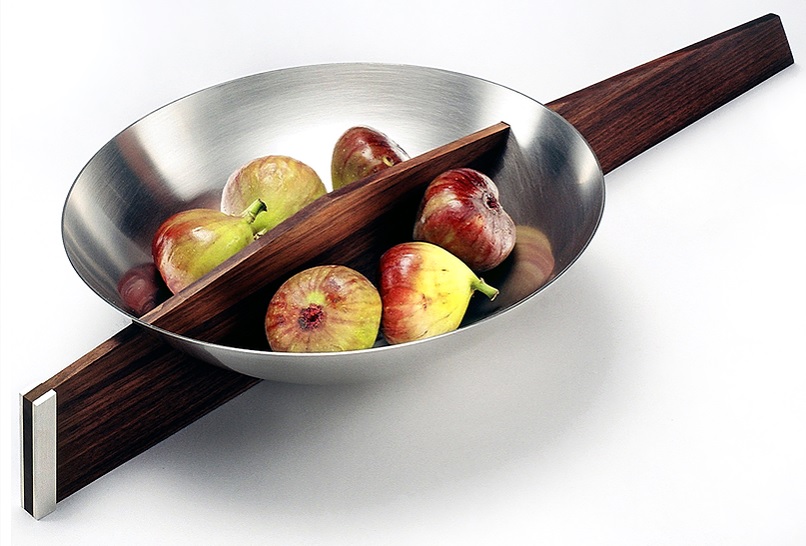In Conversation With – Silversmith Heather O’Connor talks Minimalism, Contemporary Craftsmanship and
02/10/2017 Chiswick Curates, Silver & Objects of Vertu

© Heather O'Connor 2017

© Heather O'Connor 2017
We were delighted to welcome Silversmiths Angela Cork and Heather O'Connor for an exclusive behind the scenes view of the forthcoming Silver and Objects of Vertu auction taking place on 31 October and to discuss the array of impressive craftsmanship.
Heather is a well-established London based Silversmith and Jewellery designer with a keen interest in architecture and garden design. By exploring the physicality of how a garden is planned and plotted, Heather abstracts ideas regarding the use of structure, composition, space, proportion and boundaries, exploring how these elements are used to control and support nature within a garden. She is also interested in the emotional implications offered by the use of space and boundaries within her work.
Heather’s handcrafted silverware has a perceived simplicity. She uses pure line and form to create a bold, clean aesthetic resulting in a distinctly modern collection that aims to challenge both function and display in equal measure. She has taken part in a number of prestigious exhibitions in both the UK and Europe and has work in both private and public collections, including the Hove Museum and Art Gallery and the Royal College Collection.
We talk to Heather about what inspires her, the future of silver and jewellery that she can’t live without.
What inspires your work?
My work is predominantly influenced by an interest in formal garden design, modern architecture and the urban landscape with strong reference to the use of space, structure, boundaries and composition. I explore these ideas through my designs, often combining precious metal with structural materials such as wood or concrete to create a unique modern twist.
How do you approach a new collection? Where do your ideas evolve from?
My ideas tend to evolve organically from collection to collection. As a minimalist, the key characteristics that reoccur throughout my work are clean lines, angles and pure form, as informed by my above interests, and it is often a specific shape and function that triggers the initial process when starting on something new, for example an oval or display for apples. Ideas then evolve and grow in the studio through writing, basic sketching, model making and play. Once I am happy with the basic key elements I will start focusing on the finer details, scale and proportions before translating these ideas into silver.
Sum up your aesthetic in five words.
Minimalist, modern, structural, compositional, clean.
Which silversmiths do you particularly admire and why?
There are many silversmiths practicing today whom I admire greatly, but the one who really stands out for me is Michael Rowe, who I was lucky enough to study under during my time at the RCA. I find his work awe inspiring, a true metal artist, both in concept and technique. He is a master of construction, scoring, folding and soldering sheet metal into precise geometric compositions, a process that requires exceptional skill, craftsmanship and patience.
Available at www.heatheroconnor.com
How would you say silver craftsmanship has changed over the centuries?
The beautiful thing about silversmithing is that we still employ many of the traditional techniques that have been practiced for centuries, but we now have better tooling, more refined materials and far safer procedures! Advances in technology have made many procedures quicker and easier, and new processes such as 3d printing and laser cutting are enabling silversmiths to push the boundaries of what is possible. For me, it is where the new and old techniques merge that some of the most exciting silverware occurs.
The way we learn our craft has also changed. There are far less apprenticeships, where the focus would have been very much on mastering craft techniques through repetition and hands on practice, with most contemporary smiths’ now learning the basics of their craft on design led college courses. This has had a huge impact on the kinds of pieces produced and the techniques employed nowadays.
Do you see a revival of silver in everyday use or do you see its future as an art form?
I think many of the rituals of daily life where silver would have been used have changed, and that more and more people buy contemporary silver as art pieces to display, or as sentimental keepsakes, rather than for daily use.
What is the most valuable lesson you have learned?
I have had many learning curves over the years. It is an understatement to say that making a living as an artisan can be a challenge, it's hard work and there are many elements to balance, so I think for me it is not being afraid to ask for help and advice when you need it and accepting you can’t be a master of everything! I have found the silversmithing world to be very friendly and supportive, it’s a craft of passion and the majority of makers are happy to share their skills and knowledge, and this can be an invaluable resource.
Available at www.heatheroconnor.com
Is there a piece of jewellery that you could not live without?
I have two rings that I wear on a chain that are very dear to me as they belonged to my mum, and she always wore them. One of them is a ring I made for her from her own mother's wedding ring so it has a double layer of meaning to me.
What is next for you?
I am currently working on private commissions and will be showcasing both my silverware and jewellery in a series of pop up events running from October through to Christmas as part of the Battersea Power Station redevelopment project.
For more information, visit Heather O'Connor's official website.
Silver & Objects of Vertu Department Page.